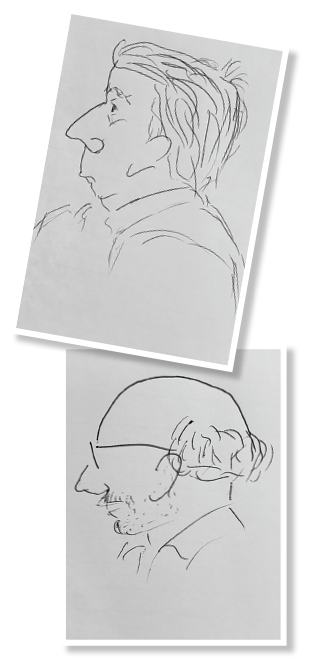 When Jonathan Kay, MD, attends a medical lecture, he does more than just listen to the speakers or watch their presentations. He typically whips out his pen and draws a caricature of someone in the room.
When Jonathan Kay, MD, attends a medical lecture, he does more than just listen to the speakers or watch their presentations. He typically whips out his pen and draws a caricature of someone in the room.
Dr. Kay is a professor of medicine and holds the Timothy S. and Elaine L. Peterson Chair in Rheumatology at the University of Massachusetts (UMass) Chan Medical School, Worcester, where he directs clinical research in the Division of Rheumatology. He is also a physician at UMass Memorial Medical Center, Worcester.
Over the years, Dr. Kay has created hundreds of caricatures of family, friends and colleagues. Perhaps his most famous subject was the attending physician at the National Institutes of Health—Anthony Fauci, MD—in 1983, when Dr. Kay was a fourth-year medical student doing a rotation in rheumatology and clinical immunology. (Shhh! Dr. Fauci, now director of the National Institute of Allergy and Infectious Diseases, doesn’t know about this one.)
“Colleagues have suggested that I put together a collection of my caricatures or that I set up a caricature booth at the ACR annual meeting to raise money for the Rheumatology Research Foundation,” Dr. Kay says. “But I don’t think I’m good enough. I just do this for fun.
“When drawing pictures of my friends, I focus on their face in the context of their personality and integrate these into a two-dimensional representation of their image.”
Parents’ Influence
By the time he graduated high school, he had achieved enough proficiency in playing this large woodwind instrument that he debated whether to attend a music conservatory or university. But he didn’t want to limit his educational experiences, and really liked biology and chemistry so he chose the latter.
The summer before he left for college, while working as a dishwasher at a delicatessen in his hometown of Brookline, Mass., Jon filled in for the vacationing dishwasher in the clinical immunology lab at Tufts New England Medical Center, Boston, where his mother worked as a lab technician.

Top Image: Caricature of John (Jack) Cush, MD, executive editor of RheumNow.com and professor of internal medicine in the rheumatic diseases division at UT Southwestern Medical School, Dallas, Texas. Drawn at a meeting in Nice, France, on March 20, 2015.
Bottom Image: Caricature of Tom W.J. Huizinga, MD, PhD, professor of rheumatology, head of the Department of Rheumatology and vice clinical educator of rheumatology, Leiden University Medical Center, The Netherlands. Drawn at a meeting in Nice, France, on March 20, 2015.
“I could sail on the Charles River in the morning and wash glassware in the afternoon,” he says. “While in the lab, rheumatology fellows showed me their experiments and really interested me in immunology. So when I entered Harvard College that fall, I took biology and chemistry courses as preparation for studying immunology. These experiences prompted me to attend medical school and pursue a career in academic rheumatology.”
In 1983, Dr. Kay graduated from the University of California, San Francisco, School of Medicine. Subsequently, he completed his internship and residency in internal medicine at the Hospital of the University of Pennsylvania, Philadelphia, and then pursued fellowships in rheumatology and immunology at the Brigham and Women’s Hospital and Harvard Medical School, both in Boston.
Over the past three decades, his research has focused on rheumatic
problems of patients with chronic kidney disease, such as beta-2-microglobulin amyloidosis and gadolinium-induced systemic fibrosis, as well as on rheumatoid arthritis and the spondyloarthropathies. More recently, he’s been involved with the development of biosimilars to treat inflammatory diseases.
In 2018, Dr. Kay received the Distinguished Service Award from the ACR and was awarded honorary membership in EULAR.
Although his background is impressive, so are his caricatures.
“While I’m listening to a lecture, my eyes may wander and look around the room,” he says. “I will notice someone sitting and listening intently to the lecture and am tempted to take a pen and draw. I focus on the essence of what makes them look as they do and try to use as few lines as possible to create an image that is identifiable as that individual.”
Capturing the True Essence
Dr. Kay says his caricatures are always of people he respects and enjoys, and who have impressed him with their personality and intellect. Although caricatures may highlight physical features they’re not especially proud of, he says these drawings are really tributes to them—both consciously and subconsciously. They reflect his positive interactions with them and the privilege of knowing them.
Dr. Kay believes there are strong similarities between drawing and being a rheumatologist, both of which rely on an acute sense of observation. He points to recognizing the pattern of joint involvement in patients with inflammatory arthritis or the characteristic physical findings of patients with systemic autoimmune diseases.
“The ability to observe and focus on key elements is an important skill necessary for both drawing and the practice of rheumatology,” he says. “So the need to focus on facial features when drawing a caricature is similar to focusing on swollen and tender joints or skin rashes when evaluating a patient, which is important for becoming a successful practitioner of the art of rheumatology.”
The next time Dr. Kay attends a lecture, someone in the room may be his next subject. He typically makes several sketches of the person, drawing simple lines on a napkin or notepad before he achieves an image that really conveys the true essence of that individual.
There may be no higher form of flattery.
Carol Patton, a freelance writer based in Las Vegas, writes the Rheum After 5 column for The Rheumatologist.
Editor’s note: Listen to Dr. Kay talk more about the art of caricature on our website: www.the-rheumatologist.org.



